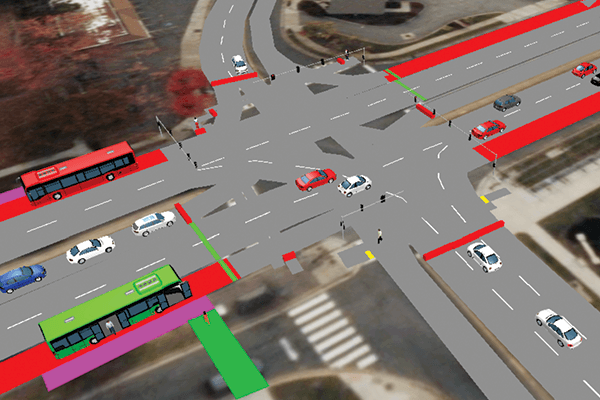What is VISSIM?
VISSIM, from German developer PTV, is the preeminent microsimulation software tool in the transportation field. Microsimulation software are used to predict how transportation networks will respond to changes and various conditions. Transportation planners and engineers can then draw conclusions regarding possible conflicts and areas for improvement. With those outcomes in hand, more informed decisions can be made regarding future development.
VISSIM (and microsimulation at large) is considered to be an “advanced” modeling tool within the transportation industry. “Advanced” often comes with the blanket connotation of “better”. What makes VISSIM “advanced” in the context of traffic modeling is the data. Every car, bus, train, pedestrian, and cyclist are individual data points. Each data point is tracked from the moment it enters the network to the moment it leaves it. Throughout its journey, various attributes are collected including speed, route, stops, acceleration and deceleration, occupancy, and much more. The level of detail doesn’t stop there. The network model can replicate the physical network down to lane widths, road curvatures, and signal control placement.
So, it’s a more detailed analysis, why not use it for every project?
The level of detail that VISSIM requires adds complexity to implementing it as part of a study. For decades, traffic analyses have been conducted successfully without the use of VISSIM. Meaning sometimes more resources are expended to use VISSIM, ultimately reaching the same conclusions as utilizing a less “advanced” tool. For this reason, it’s best to think of VISSIM as a tool in a much larger toolbox available for traffic analysis. While VISSIM is unquestionably more detailed and comprehensive than many other tools, that doesn’t mean those other tools are obsolete or without value. VISSIM is an advanced and powerful tool, but it is not the only tool available.
When is VISSIM the right tool for the job?
In most applications, the tried-and-true methods work just fine. It is relatively rare for a project to include a microsimulation component and the selection of analysis methodology is at the discretion of the reviewing agency. When beginning a project, Gorove Slade conducts meetings with the appropriate agency to agree upon scope of work including whether or not microsimulation is the appropriate tool for the job. VISSIM is advantageous in settings when at least one (and preferably more) of the following are true:
- Intersections or the roadway are configured uniquely (clustered or closely spaced intersections, unique traffic signal phasing)
- Network includes multiple facility types (e.g., where freeway ramps connect to an urban network)
- Active transportation modes frequently interact with vehicles outside of specific controlled locations
- Buses (or other transit modes) operate in dedicated lanes or separate right-of-way from personal vehicles
- Networks exhibit oversaturated conditions in most or all peak periods
Have more questions about VISSIM?
Gorove Slade’s transportation modeling team has project experience modeling all of the above scenarios using VISSIM in various local jurisdictions. Gorove Slade is pleased to offer VISSIM modeling as a tool within our larger toolbox of transportation services. To learn more about how VISSIM can be applied to projects and when it is appropriate, contact Adam Nodjomian-Escajeda at [email protected].
 June 20, 2023
June 20, 2023
